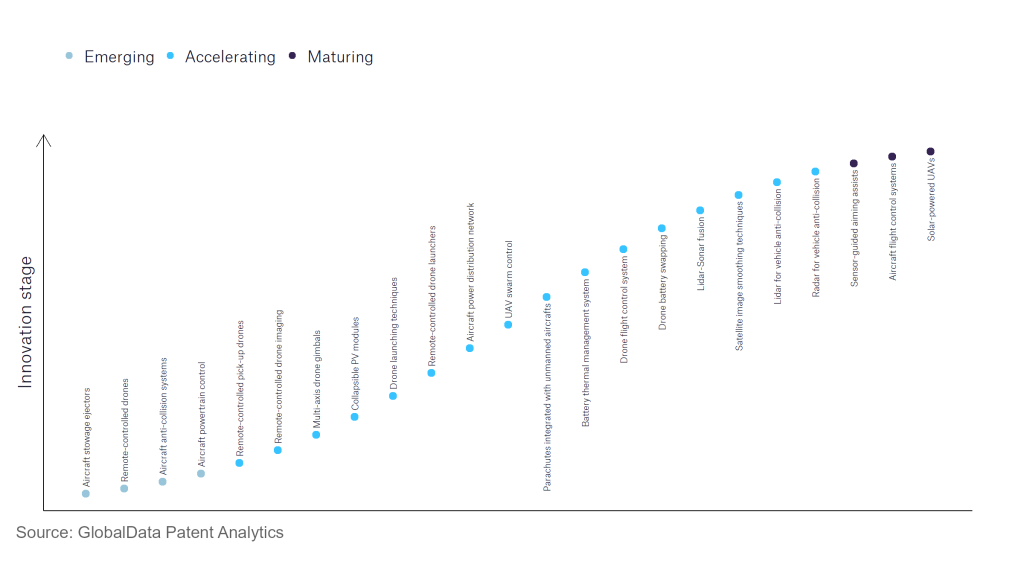The aerospace and defence industry continues to be a hotbed of innovation, with activity driven by the need to lower operational costs, larger consumer trends, and electrification, and growing importance of technologies such as hydrogen and electric aircraft and advanced materials. In the last three years alone, there have been over 174,000 patents filed and granted in the aerospace and defence industry, according to GlobalData’s report on Internet of Things in Aerospace, Defence & Security: Aircraft flight control systems. Buy the report here.
However, not all innovations are equal and nor do they follow a constant upward trend. Instead, their evolution takes the form of an S-shaped curve that reflects their typical lifecycle from early emergence to accelerating adoption, before finally stabilising and reaching maturity.
Identifying where a particular innovation is on this journey, especially those that are in the emerging and accelerating stages, is essential for understanding their current level of adoption and the likely future trajectory and impact they will have.
180+ innovations will shape the aerospace and defence industry
According to GlobalData’s Technology Foresights, which plots the S-curve for the aerospace and defence industry using innovation intensity models built on over 262,000 patents, there are 180+ innovation areas that will shape the future of the industry.
Within the emerging innovation stage, hydrogen fuel cells, aircraft powertrain controls, and fuel cells for aircraft are disruptive technologies that are in the early stages of application and should be tracked closely. EV charging stations, hybrid propulsion aircraft engines, and electric aircraft charging interfaces are some of the accelerating innovation areas, where adoption has been steadily increasing.
Innovation S-curve for Internet of Things in the aerospace and defence industry

In fixed-wing aircraft there are numerous parts that combine to form the flight control system. This will usually consist of flight control surfaces, cockpit controls, connecting linkages, as well as mechanisms that control the direction of flight. Controls relating to the engine are includes within this definition.
GlobalData’s analysis also uncovers the companies at the forefront of each innovation area and assesses the potential reach and impact of their patenting activity across different applications and geographies. According to GlobalData, there are 20+ companies, spanning technology vendors, established aerospace and defence companies, and up-and-coming start-ups engaged in the development and application of aircraft flight control systems.
Key players in aircraft flight control systems – a disruptive innovation in the aerospace and defence industry
‘Application diversity’ measures the number of different applications identified for each relevant patent and broadly splits companies into either ‘niche’ or ‘diversified’ innovators.
‘Geographic reach’ refers to the number of different countries each relevant patent is registered in and reflects the breadth of geographic application intended, ranging from ‘global’ to ‘local’.
Patent volumes related to aircraft flight control systems
Source: GlobalData Patent Analytics
Mitsubishi Electric is one of the leading patent filers in aircraft flight control systems. Mitsubushi has a history of collaborating with defense primes (such as BAE Systems) to provide updated and advanced flight control systems to military aircraft. Some other key patent filers include Canon, SZ DJI Technology, Yamaha Motor, KDDI, Nileworks and Sony Group.
In terms of application diversity, SoftBank Group leads the pack. Mitsubishi Electric and Zero stood in the second and third positions respectively. By means of geographic reach, Yamaha Motor held the top position followed by Mitsubishi Electric and Zero.
Aircraft flight control systems are being improved by industrial actors. Many non-defense companies have filed patents in this field. One defense firm has been proactively filing in this topic – this is Aeronext. As recently as September 2022, Aeronext entered a business alliance with KDDI SmartDrone (a drone technologies firm) to explore flight control systems on unmanned aircraft.
To further understand how Internet of Things is disrupting the aerospace and defence industry, access GlobalData’s latest thematic research report on Thematic Research - Internet of Military Things.
Data Insights
From

The gold standard of business intelligence.
Blending expert knowledge with cutting-edge technology, GlobalData’s unrivalled proprietary data will enable you to decode what’s happening in your market. You can make better informed decisions and gain a future-proof advantage over your competitors.



